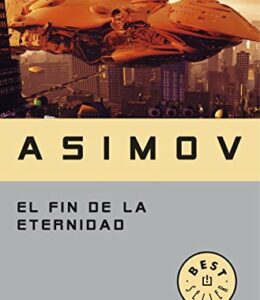
15 Oct Time travel book: the end of eternity
Much has already happened since he discovered a heavy weight of science fiction, Isaac Asimov. On this occasion I recommend a classic envelope the time travel with which you can embark upon a exciting history over time. And that the novel is full of concepts to think about the future of mankind how species, wrapped in a technological environment with philosophical background.
A perfect novel for give wings to our imagination to travel in the time until the end of time.
I leave you a fantastic summary of the plot, a both spoileada that Yes.
Eternity is a place and an organization that exists beyond time. It is composed of only men who are recruited from different moments in the history of mankind from the 27TH century. The Eternals have the ability, by technological means, enter and exit at almost any point of the current temporary and travelling through it, altering it. Although a period except itself: the hidden centuries, ranging from century 70,000 to the 150,000. Together they form a body of guardians who carry out, calculating and planning carefully, the strategic minimum actions in the temporal world, calls reality changes, in order to minimize the collective suffering in the history of mankind. The executors are responsible for subtly alter the course of the time protecting humanity, in order to minimize the human suffering in the history. As a consequence, humanity dumps all its technological development capacity for the journey back in time and it leaves the Star Search. In fact, one of the side effects of the Eternals travel is, that to reduce human suffering, they sabotage any attempt at development of technologies that would allow interstellar travel.
A key element of the novel is the relatively static nature of human societies in the various future centuries, and repeated failures of space navigation. We can see that Twissell (the head of eternity) is the "century 30,000" - 3 million years in the future - but their anatomy is not very different to the modern man.
The protagonist of the novel, Andrew Harlan, is an executor especially linked to Twissell, which begins to distrust their own actions in eternity, being able to fall in love and begin to make impulsive actions against their own world. He falls for a woman, Noys Lambent, entered into eternity as Secretary, and suspicion that his superior, the programmer Hobbe pretends, tried to get involved with her, but it refused. They finally assigned a mission that involves spending a week at the House of Noys. While you are doing this, ends up succumbing to their impulses and just falling in love with her. He realizes that they could remove it from his century to effect a change in reality, and would not allow him a relationship with her. Why hide it, violating laws, in the span of eternity where humans do not exist: the hidden centuries.
After a while, trying to bring him supplies, realizes that there is a temporary barrier that he can not pass through. The turning point of the story comes when Harlan understands that it is part of a paradoxical plan to ensure the creation of eternity by sending a young eternal to a bygone era, with the mathematician to make possible knowledge the journey back in time. Harlan sabotages the mission, sending the eternal to the 20th century.
Looking for a message of the eternal lost in any of the magazines of the 20th century, they are an advertisement in the form of a cloud of fungus and a message whose initials form the word "ATOM". Harlan, mildly repentant, helps his superior on the condition that Noys follow with it. Both travel to the 20th century and there Harlan discovers the truth: Noys is a human of the hidden centuries, which convinces him that Eternals are not aware that their very existence is the greatest danger for humanity which attempt to protect, limiting their future development in interstellar travel. In this way, they leave the mission, and eternity is destroyed to ever be created: the end of eternity.
In this novel Asimov solve brilliantly the temporal paradox what if I turn back to the past and somehow caused the death of my grandparents? Can I then be I live?.
The novel, on the other hand, exposes one of the favorite theses of Asimov: only the exercise of freedom by the societies and the human species - with his courtship of successes and failures - will ensure their future development; the restriction on the exercise of freedom will result in the medium or long term in decline. Such thesis forcing the own Asimov to refocus the topic of psychohistory and incorporate the freedom of choice, as in the limits of the Foundation and Foundation and Earth, the last 2 books of the cycle of Trantor.
Asimov includes some tracks on the edge of the foundation that the Eternals might have been responsible for the Galaxy inhabited only by humans of the Saga of the Foundation. However this interpretation does not clearly fit.
Source Wikipedia.
.
![The Ministry of time - season 2 [Blu-ray]](https://viajeroseneltiempo.es/storage/2016/09/El-Ministerio-Del-Tiempo-Temporada-2-Blu-ray-0-260x300.jpg)




![La Teoría Del Todo [Blu-ray] - Stephen Hawking](https://viajeroseneltiempo.es/storage/2016/09/La-Teora-Del-Todo-Blu-ray-0-260x300.jpg)








 The end of eternity (BEST SELLER)
The end of eternity (BEST SELLER)



No Comments